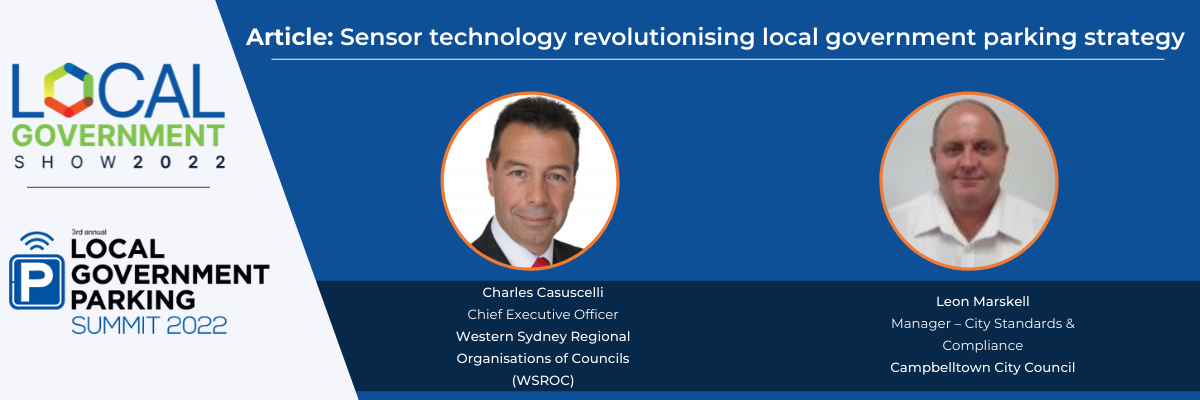Every year the average Australian driver spends fourteen hours looking for parking spots, driving 560 kms and burning 59 litres of fuel in the process. This suggests as much as $1.3 billion is spent in Australia just looking for somewhere to park.
This is one of the many challenges delegates at the 3rd annual Local Government Parking Summit 2022 will discuss in early November. We spoke with Charles Casuscelli (CEO, Western Sydney Regional Organisation of Councils) and Leon Marskell (Manager, City Standards and Compliance at Campbelltown City Council) about potential solutions to local parking challenges and how to best implement them.
IoT connectivity and smart parking technology
Existing at the intersection between Industry 4.0 and smart cities, IoT-enabled smart parking leverages technologies, including artificial intelligence and machine learning, to supercharge parking efficiencies.
Parking sensors are only a small part of a broader trend toward public spaces being equipped with sensor technology.
“The public domain, especially that which comes under the jurisdiction of Local Government, is currently subject to the rapid deployment of various sensors, gadgets and gizmos providing all manner of data and information, including parking information,” says Casuscelli.
IoT sensors installed in empty parking spaces send data (via a wireless connection) to a cloud server. The collected data produces a real-time, app-based map enabling drivers to be guided to an available parking space. There is also the potential for drivers to use these systems to reserve and pay for parking spaces in advance.
For councils, sensor data accurately measures parking usage, and supply and demand, to guide policy and strategic decisions. The technology could also change how councils manage parking zones, fees and overstays.
IoT sensors may be ultrasonic (bouncing a signal off the underside of any parked vehicle), electromagnetic (detecting changes to the magnetic field caused by proximity to metal), or infrared (detecting motion and temperature changes).
“The community’s appetite for accessing real-time parking availability and accessibility is one of the biggest growth trends since the onset of the pandemic,” says Marskell.
While councils are spoilt for choice with the wide variety of solutions available, they must also manage the costs involved in incorporating this technology.
“The number of apps becoming available creates a real dilemma for Local Government as [the apps] are not generally integrated into the councils’ corporate operating systems,” Marskell says. “The other issue is the hidden costs in upgrading these solutions to meet the needs of the local council, as no two councils operate in the same way.”
Similarly, Casuscelli notes that the integration challenges involved are significant. “Integration or interoperability between platforms or a framework to guide the implementation of technology (parking or otherwise) is virtually non-existent.”
Integration with other services
Thinking beyond the immediate needs of drivers seeking parking spaces for their daily commutes, Casuscelli says the real question is how parking sensor technology, platforms, and systems, can be integrated or made interoperable with everything else happening in the public domain.
“For example, how can we link [sensor-enabled] parking plans to special events, road works, building construction activity, and public transport infrastructure and services?”
Smaller councils may be left behind
Marskell says while the technology will improve visibility and help guide parking policy to unlock long-term benefits, upfront costs will be prohibitive for smaller councils. "Whilst the technology is available today, it comes at a cost. The larger councils are in a financial position to invest in the technology, whilst the smaller ones are left behind," he warns.
Larger (metropolitan) councils generally have larger populations and more traffic, so their need is more pressing. Still, even the smallest councils can have significant parking challenges due to poor inherited street design.
Consultation is key
Marskell believes a dynamic and well-planned procurement process is essential for choosing the right solution, as is stakeholder involvement. "This is a significant opportunity for Local Government. However, there needs to be a ‘think tank’ on the best solution to help create universal buy-in and ensure appropriate procurement measures have been taken."
“It’s about consultation, consultation, consultation. Start with internal stakeholders because the parking plan will need buy-in from the people responsible for delivering it before you go to the external community. Consultation with the business sector is critical in the major CBD areas. It's equally important to engage with the Chamber of Commerce and small businesses to outline the intentions of the parking plan, its timeframes and costs. Finally, consult with elected members because many good parking plans have come undone through poor execution and a lack of consultation at the political level. This can put planning back by years, if not decades."
Solving challenges together
Getting parking right is essential to creating vibrant, liveable, sustainable and economic places, so it's vital you gain the correct information from those leading the way to help you rethink and update your parking strategy.
Those working at the forefront of solving these issues will come together at the 3rd annual Local Government Parking Summit to share the latest information, trends, and successful approaches in this area.
To view the Local Government Parking Summit agenda click here or download the brochure here.

